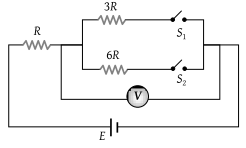A battery of internal resistance 4Ω is connected to the network of resistances as shown. In order to give the maximum power to the network, the value of R (in Ω) should be :

1. 4/9
2. 8/9
3. 2
4. 18

In the circuit shown here, the readings of the ammeter and voltmeter are
1. 6 A, 60 V
2. 0.6 A, 6 V
3. 6/11 A, 60/11 V
4. 11/6 A, 11/60 V
Length of a hollow tube is 5m, it’s outer diameter is 10 cm and thickness of it’s wall is 5 mm. If the resistivity of the material of the tube is 1.7 × 10–8 Ω×m then the resistance of the tube will be :
1. 5.6 × 10–5 Ω
2. 2 × 10–5 Ω
3. 4 × 10–5 Ω
4. None of these
A wire of resistor R is bent into a circular ring of radius r. Equivalent resistance between two points X and Y on its circumference, when angle XOY is α, can be given by
1.
2.
3. R (2π – α)
4.
As the switch S is closed in the circuit shown in the figure, the current passed through it is :
1. 4.5 A
2. 6.0 A
3. 3.0 A
4. Zero
In the following circuit, a 10 m long potentiometer wire with resistance 1.2 ohm/m, a resistance R1 and an accumulator of emf 2 V are connected in series. When the emf of the thermocouple is 2.4 mV then the deflection in the galvanometer is zero. The current supplied by the accumulator will be :
1. 4 × 10–4 A
2. 8 × 10–4 A
3. 4 × 10–3 A
4. 8 × 10–3 A
In the following circuit, bulb rated as 1.5 V, 0.45 W. If bulbs glows with full intensity then what will be the equivalent resistance between X and Y
1. 0.45 Ω
2. 1 Ω
3. 3 Ω
4. 5 Ω
Consider the circuits shown in the figure. Both the circuits are taking same current from battery but current through R in the second circuit is th of current through R in the first circuit. If R is 11 Ω, the value of R1
1. 9.9 Ω
2. 11 Ω
3. 8.8 Ω
4. 7.7 Ω
In order to quadruple the resistance of a uniform wire, a part of its length was uniformly stretched till the final length of the entire wire was 1.5 times the original length, the part of the wire was fraction equal to
1. 1 / 8
2. 1 / 6
3. 1 / 10
4. 1 / 4
In the circuit shown in figure reading of voltmeter is V1 when only S1 is closed, reading of voltmeter is V2 when only S2 is closed and reading of voltmeter is V3 when both S1 and S2 are closed. Then
1. V3 > V2 > V1
2. V2 > V1 > V3
3. V3 > V1 > V2
4. V1 > V2 > V3








